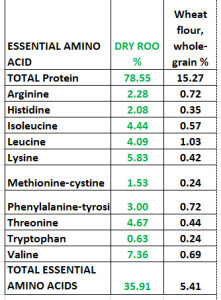Kangaroo essential amino acids are much greater than grains.
 The previous article on this site showed how ESSENTIAL and non essential amino acid amounts could be calculated for the red kangaroo meat. This information was previously unavailable on the internet.
The previous article on this site showed how ESSENTIAL and non essential amino acid amounts could be calculated for the red kangaroo meat. This information was previously unavailable on the internet.
The reason I did this was that kangaroo is touted as a super food for humans and dogs alike, but little factual information has been available on its protein or amino acid values.
For a brief recap, TEN of the 22 amino acids (the small chain chemicals that make up protein) are considered ESSENTIAL amino acids, and must be eaten by animals to achieve minimum health levels. The AAFCO (a dog association) provides minimum nutritional requirements for dogs including the minimum amounts of Essential amino acids.
How does kangaroo meat proteins (amino acids) compare to grains found in dog food?
This site provides information on the nutritional value of kangaroo meat, which backs up the reason why kangaroo dog treats are vital to a dog’s health.
The previous article compared kangaroo meat with other meats regularly used in dog food so that you could see what amino acids Kangaroo meat contained that were different and higher than regular meats used.
Of course this assumes that good quality cuts of meat are used in dog food and not poor quality off cuts, which is often the case.
This article compares essential amino acids amounts found in kangaroo meat with those found in grains that are regularly used in dog food.
The table below was created by using nutritional data originally from data tables and adjusting all essential amino acids to the higher levels they would be present in roo meat and grains when water is removed from these food sources. The reason for this is that the AAFCO minimum essential amino acid standards created in the USA require dog food to achieve these minimum levels for DRY FOOD, to be allowed to be called “whole and complete” dog food.
I repeat – the minimum essential amino acid values in the table below are for DRY FOOD SOURCES – hence why the amino acids of kangaroo and grains (BELOW) has been calculated SANS water.
ESSENTIAL AMINO ACIDS minimum AAFCO levels and kangaroo meat and grains
RAW Meat typically has a moisture content between 65 and 75% water.
The grains in this table have a water content of between 9 and 12%
As you can see, when kangaroo meat and the grains have their amino acids calculated as a percentage of the food, without water, the grains still fail the minimum requirement for many essential amino acids (shown in RED).
The vast majority of dogs are fed a commercial food diet, so at the risk of offending the vast majority of people reading this .. grains are mainly used in dog food as a bulk filler. While they have some of the vitamins and minerals that are required by the AAFCO tables, extra vitamins and minerals are usually also added to make the minimum requirement.
You should also realize that the grains I selected for showing in the table are the healthiest versions. Many of the grains used in dog food are a more processed version or considered generally less healthy for dogs (such as white rice instead of brown, or processed wheat flour rather than whole wheat) and so the essential amino acids in grains used in dog foods are likely to be lower still.
Processing of grains in the creation of dog food pellets (heat treatment, storage etc) also tends to diminish the nutritional value of the grains or flours.
The AAFCO minimum levels shown are for adult dogs on a maintenance diet. Dogs that are puppies, pregnant, old or sick require much higher levels of amino acids. Dogs that are working dogs or given significant exercise also require higher levels of amino acids. Dogs that have thick coats or continually growing coats such as poodles devote a significant amount of their protein intake to creating their hair – this can cause an essential amino acid deficit.
You should be able to see from the tables that it is obvious from the minimal levels of most grain amino acids, that MEATS (and ideally organic Kangaroo meat) are required (at least) to be added to commercial dog food to provide the required amino acids.
The relatively low palatability and bio availability of grains and vegetables to dogs that are essentially carnivores, also requires grains to be significantly processed for them to provide any level of digestibility.
CONCLUSION
As discussed in the previous articles on meat essential amino acids, meats provide a valuable nutritional addition to a manufactured dog food diet. Quality meats provide quality essential amino acids that are easiest for dogs to digest.
Kangaroo meat and kangaroo meat dog treats provide a different essential amino acid profile from all other meats. If you don’t already feed your dog kangaroo meat, then kangaroo dog treats are an ideal supplement to balance out the amino acid profiles of manufactured dog foods that contain common meats such as beef and chicken.



